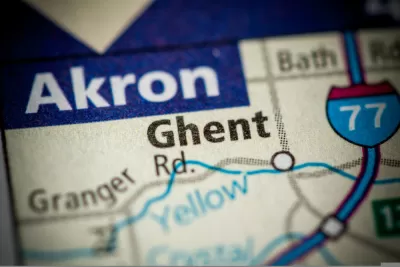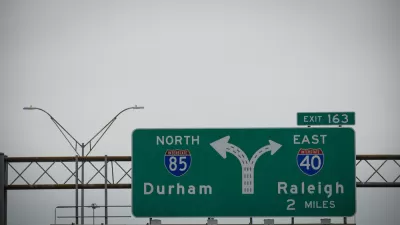The Ohio Department of Transportation wants to add lanes to Interstate 77 outside Akron to reduce congestion. Some local officials think the project will connect the region to the East Coast; others think the money would be better spent locally.

"The Ohio Department of Transportation is seeking feedback on its $125 million plans to add lanes to a 9.2-mile section of Interstate 77 in Summit County, a project that already has some detractors," reports Robin Goist.
Those detractors are Jason Segedy, Akron’s director of planning and urban development, and Becky Corbett, trustee of the Bath Township. Segedy's criticisms of the project focus on the spending priorities exhibited by the project. Segedy says the money would do more good in the urban core, and that ODOT should follow the city of Akron's lead in adopting a "fix it first" approach to transportation infrastructure. Corbett argues that the project's impermeable pavement will exacerbate stormwater challenges in the areas around the project.
The criticisms stand in contrast to the views expressed in an earlier article by Goist, which found support for the project from Summit County Executive Ilene Shapiro announced through a spokesperson support for the project for economic development purposes. State Rep. Emilia Sykes of Akron expressed support for the project on similar grounds. The Summit County economic development website makes the case for the highway project by touting the region's proximity to the outside world. The county is located within an "eight-hour drive of half of the U.S. population and two-thirds of the Canadian economic base. In addition to being centrally located between Cleveland, Detroit, Columbus and Pittsburgh, metropolitan markets within a 500 miles radius of Summit County include New York City, Washington, D.C., Chicago and Nashville," according to Goist.
For more details on the proposed project, Goist provides the following in the more recent article:
ODOT announced earlier this month its plans to add a third lane in each direction to I-77 between Ghent Road and the Ohio Turnpike, which spans Fairlawn, Bath, Richfield Township and the Village of Richfield. The construction project has been divided in two, with the stretch from Ghent Road to Everett Road expected to cost $50 million, and the section from Everett Road to the Ohio Turnpike estimated to cost $75 million.
In the previous article, Goose provides the following additional information about ODOT's decision to widen the freeway:
ODOT said it has conducted traffic studies and determined that a third travel lane in each direction would improve traffic flow, and that the best course of action would be to build additional lanes in the center median. The project also calls for other improvements, including bridge and pavement repairs, drainage improvements, lighting upgrades, sign replacements and pavement markings, according to ODOT.

Planetizen Federal Action Tracker
A weekly monitor of how Trump’s orders and actions are impacting planners and planning in America.

Maui's Vacation Rental Debate Turns Ugly
Verbal attacks, misinformation campaigns and fistfights plague a high-stakes debate to convert thousands of vacation rentals into long-term housing.

Restaurant Patios Were a Pandemic Win — Why Were They so Hard to Keep?
Social distancing requirements and changes in travel patterns prompted cities to pilot new uses for street and sidewalk space. Then it got complicated.

In California Battle of Housing vs. Environment, Housing Just Won
A new state law significantly limits the power of CEQA, an environmental review law that served as a powerful tool for blocking new development.

Boulder Eliminates Parking Minimums Citywide
Officials estimate the cost of building a single underground parking space at up to $100,000.

Orange County, Florida Adopts Largest US “Sprawl Repair” Code
The ‘Orange Code’ seeks to rectify decades of sprawl-inducing, car-oriented development.
Urban Design for Planners 1: Software Tools
This six-course series explores essential urban design concepts using open source software and equips planners with the tools they need to participate fully in the urban design process.
Planning for Universal Design
Learn the tools for implementing Universal Design in planning regulations.
Heyer Gruel & Associates PA
JM Goldson LLC
Custer County Colorado
City of Camden Redevelopment Agency
City of Astoria
Transportation Research & Education Center (TREC) at Portland State University
Jefferson Parish Government
Camden Redevelopment Agency
City of Claremont





























